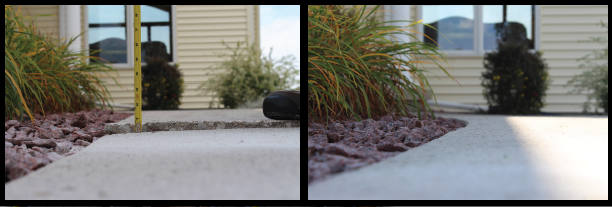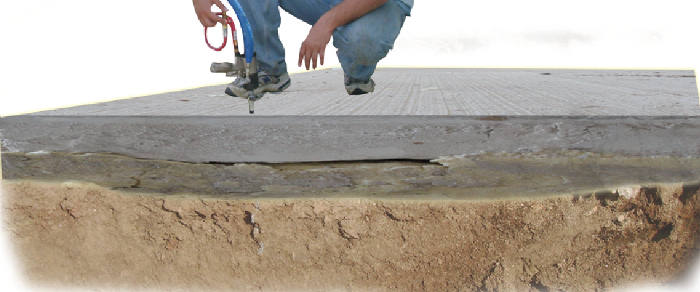
Grinding: This is an inexpensive option that is unattractive. Grinding exposes aggregate in the concrete which makes this unappealing. The integrity and strength of the slab is also compromised when using this method. Slabs that continue to settle after grinding cannot be raise back to original levels.
Replacement: This option is the most expensive option. It is also very time consuming. This method may lead to downtime for businesses, loss of productivity, and lost revenues. The finished colors of the new slab will not match existing adjacent concrete.
Raising & Stabilizing: This may be done with traditional mudjacking or cementitous grouting. This process utilizes a hydraulically powered pump to install a slurry mix under the slab with enough pressure to compact weak soil underneath and raise the slab. Water, fly ash, top soil, sand, clay, agricultural lime, and cement are materials used to create these slurries. This method, when used on subgrade that has already settled, adds excessive weight and may lead to resettling.
Raising and Stabilizing-Polyurethane Foam: With HMI polyurethane, the HMI method for concrete raising utilizes the slab itself as a means of delivering raising, void filling, and stabilizing foam. A 5/8” hole is drilled through the slab into the subgrade. A tapered delivery port is then installed in the 5/8”hole. The injection equipment, which delivers the dual component polyurethane material, is then connected to the port. Material is then injected through the port and under the slab. Expansion of the material occurs within seconds, compressing loose soils and raising concrete.
Raising concrete with polyurethane foam is done with controlled incremental injections. Lifting foam will fully expand within 10-15 seconds. This allows the applicator to monitor the raise and prevents over raising the slab. HMI suggests using air purged equipment to deliver foam under the slab. This equipment will keep the injection port open between injections, allowing for the installer to wait for foam to fully expand before injecting more material.

Void Filling: Concrete settling is not the only issue that HMI Foam can solve. Voids under slabs are often present in areas where wash out or excessive settling can occur. HMI material will weigh on average 15-25 times less than a traditional mudjacking or cementitious grout mix. This lightweight material will put less stress on an already failed subgrade. The process of drilling, port installation, and injecting the material is the same as the raising process. All dual component polyurethane foams create heat when installed. Void fills must be done in a layering method to allow heat to dissipate safely. HMI issues a Stewardship manual to all dual component polyurethane customers. This manual covers safety precautions that must be observed when injecting dual component polyurethane foams.
Joint/Slab Stabilization: Slab stabilization is often required when slabs lack support, but may or may not be settled. Slabs can crack when loads exceeding its capacity are applied . Slab/joint stabilization applications require the voids be filled to eliminate slab movement and offer support.
HMI foam specifically designed for joint/slab stabilization has a very long reaction time and minimal expansion strength. It will take longer to expand, allowing for better coverage under the slab or down a void along a joint.